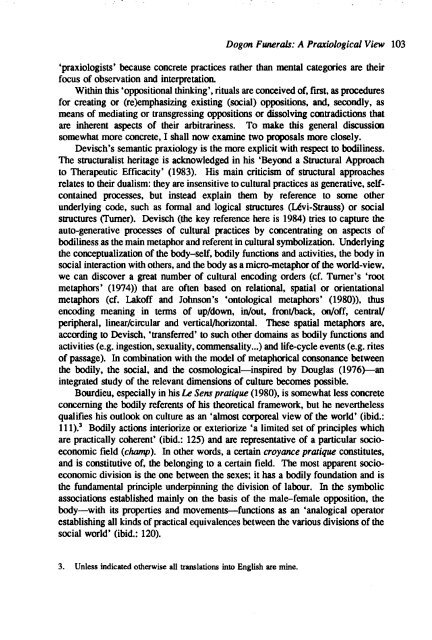1991 No. 1 CONTENTS - Institute of Social and Cultural ...
1991 No. 1 CONTENTS - Institute of Social and Cultural ...
1991 No. 1 CONTENTS - Institute of Social and Cultural ...
You also want an ePaper? Increase the reach of your titles
YUMPU automatically turns print PDFs into web optimized ePapers that Google loves.
Dogon Funerals: A Praxiological View 103<br />
'praxiologists' because concrete practices rather than mental categories are their<br />
focus <strong>of</strong> observation <strong>and</strong> interpretation.<br />
Within this 'oppositional thinking', rituals are conceived <strong>of</strong>, first, as procedures<br />
for creating or (re)emphasizing existing (social) oppositions, <strong>and</strong>, secondly, as<br />
means <strong>of</strong> mediating or ttansgressing oppositions or dissolving contradictions that<br />
are inherent aspects <strong>of</strong> their arbitrariness. To make this general discussion<br />
somewhat more concrete, I shall now examine two prqx>Sals more closely.<br />
Devisch's semantic praxiology is the more explicit with respect to bodiliness.<br />
The structuralist heritage is acknowledged in his 'Beyond a Structural Approach<br />
to Therapeutic Efficacity' (1983). His main criticism <strong>of</strong> structural approaches<br />
relates to their dualism: they are insensitive to cultural practices as generative, selfcontained<br />
processes, but instead explain them by reference to some other<br />
underlying code, such as fonnal <strong>and</strong> logical structures (Uvi·Strauss) or social<br />
structures (Turner). Devisch (the key reference here is 1984) tries to capture the<br />
auto-generative processes <strong>of</strong> cultural practices by concentrating on aspects <strong>of</strong><br />
bodiliness as the main metaphor <strong>and</strong>. referent in cultural symbolization. Underlying<br />
the conceptualization <strong>of</strong> the body-self, bodily functions <strong>and</strong> activities, the body in<br />
social interaction with others, <strong>and</strong> the body as a micra.metaphor <strong>of</strong> the world-view,<br />
we can discover a great number <strong>of</strong> cultural encoding orders (cf. Turner's 'root<br />
metaphors' (1974» that are <strong>of</strong>ten based on relational, spatial or orientational<br />
metaphors (cf. Lak<strong>of</strong>f <strong>and</strong> Johnson's 'ontological metaphors' (1980», thus<br />
encoding meaning in terms <strong>of</strong> up/down, in/out, front/back, on/<strong>of</strong>f, centtall<br />
peripheral, linear/circular <strong>and</strong> vertica1/horizontai. These spatial metaphors are,<br />
according to Devisch, 'transferred' to such other domains as bodily functions <strong>and</strong><br />
activities (e.g. ingestion, sexuality, commensality ...) <strong>and</strong> life-cycle events (e.g. rites<br />
<strong>of</strong> passage). In combination with the model <strong>of</strong> metaphorical consonance between<br />
the bodily, the social, <strong>and</strong> the cosmological-inspired by Douglas (1976)-an<br />
integrated study <strong>of</strong> the relevant dimensions <strong>of</strong> culture becomes possible.<br />
Bourdieu, especially in his Le Sens pratique (1980), is somewhat less concrete<br />
concerning the bodily referents <strong>of</strong> his theoretical framework, but he nevertheless<br />
qualifies his outlook on culture as an 'almost corporeal view <strong>of</strong> the world' (ibid.:<br />
111).3 Bodily actions interiorize or exteriorize 'a limited set <strong>of</strong> principles which<br />
are practically coherent' (ibid.: 125) <strong>and</strong> are representative <strong>of</strong> a particular socioeconomic<br />
field (champ). In other words, a certain croyance pratique constitutes,<br />
<strong>and</strong> is constitutive <strong>of</strong>, the belonging to a certain field. The most apparent socia.<br />
economic division is the one between the sexes; it has a bodily foundation <strong>and</strong> is<br />
the fundamental principle underpinning the division <strong>of</strong> labour. In the symbolic<br />
associations established mainly on the basis <strong>of</strong> the male-female opposition, the<br />
body-with its properties <strong>and</strong> movements--functions as an 'analogical operator<br />
establishing all kinds <strong>of</strong> practical equivalences between the various divisions <strong>of</strong> the<br />
social world' (ibid.: 120).<br />
3. Unless indicated otherwise all translations into English are mine.
















